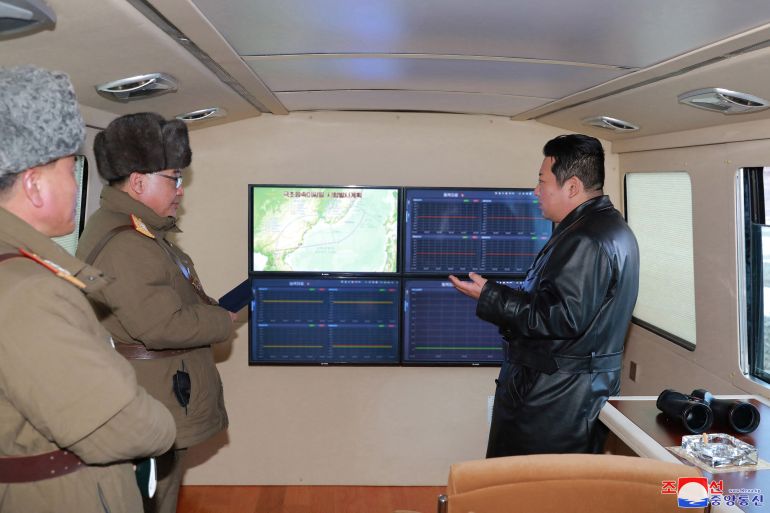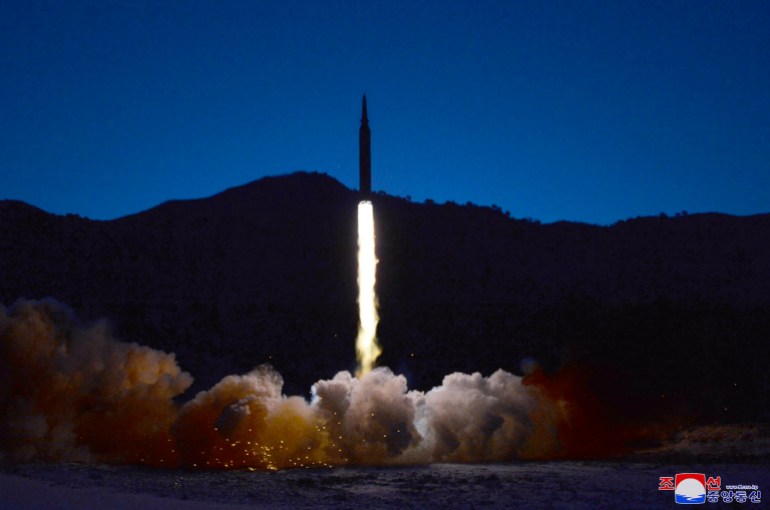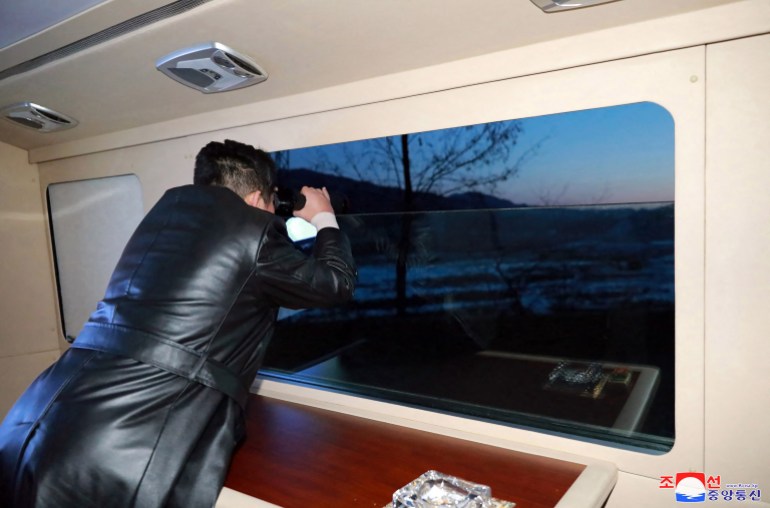Kim backs ‘military muscle’ as he watches hypersonic missile test
North Korean leader pictured at test launch for first time in nearly two years underlining commitment to advanced weaponry.

North Korea’s leader Kim Jong Un personally oversaw the successful test of a hypersonic missile and called on scientists to accelerate efforts to build up the country’s “military muscle”, state media reported on Wednesday.
It is the first time Kim has been shown attending a missile launch in nearly two years.
Keep reading
list of 4 itemsNorth Korea says Wednesday test was hypersonic missile
North Korea fires suspected ballistic missile: Japan, South Korea
South Korea’s Moon pledges final push for peace with North
Rodong Sinmun, the official newspaper of the ruling Workers’ Party, splashed the launch on its front page with photographs posted on its website showing Kim Jong Un dressed in a long, black leather coat and using binoculars to watch the launch. Other images showed the missile blasting off in a cloud of smoke and Kim on a train discussing charts with officials, including his sister.
“The superior manoeuvreability of the hypersonic glide vehicle was more strikingly verified through the final test-fire,” the official Korean Central News Agency said, indicating that the launch involved a missile that was first tested last week.
Japan and South Korea both reported the launch on Tuesday, saying they suspected it was a ballistic missile, which is banned by the United Nations.
Despite the imposition of international sanctions and a deteriorating economy, Kim has pushed for the modernisation of North Korea’s military and the adoption of more sophisticated weaponry since he took power a decade ago.

Hypersonic missiles were listed among the “top priority” tasks for strategic weapons in the North’s current five-year plan, and it carried out its first test – of the Hwasong-8 – in September 2021. Kim vowed to continue building up the country’s defence capabilities at a key meeting of North Korea’s ruling party last month.
After watching the test, Kim urged military scientists to “further accelerate the efforts to steadily build up the country’s strategic military muscle both in quality and quantity and further modernise the army”, the KCNA said.
Chad O’Caroll, who heads the Korea Risk Group, which monitors North Korea, said the prominence given to Kim’s presence at the launch was significant.
“It means Kim is not concerned about being personally associated w/ tests of major new tech. and doesn’t care how the U.S. sees this,” he wrote on Twitter.
Kim had not been pictured at a missile launch since March 2020.
“North Korea’s so-called hypersonic weapon is not technologically ready for deployment. But state media hyped the latest test, personally supervised by Kim Jong-un, as ‘final verification’ of a new military capability,” Leif-Eric Easley, a professor at Ewha University in Seoul, said in emailed comments. “This looks like classic North Korean box checking, claiming success of an agenda item from Kim’s earlier speech in an attempt to bolster political legitimacy and increase diplomatic pressure. Nonetheless, Pyongyang’s ability to threaten its neighbors continues to grow, underlining the urgency of U.S.-South Korea-Japan cooperation on missile defense and the need for greater accountability in China and Russia’s enforcement of UN sanctions.”
Everything about this test is a reminder that North Korea is all-in on a new military modernization campaign. Kim’s working his way down his 8th Party Congress wish list and is once again personally guiding tests.
— Ankit Panda (@nktpnd) January 11, 2022
Talks on denuclearisation have been stalled since the collapse of a 2019 summit between Kim and then US president Donald Trump, with Pyongyang saying the United States and its allies must stop “hostile policies” such as sanctions or military drills for diplomacy to resume.
US Undersecretary of State for Political Affairs Victoria Nuland called the launches dangerous and destabilising.
“It obviously takes us in the wrong direction,” she said at a briefing in Washington on Tuesday. “As you know, the United States has been saying since this administration came in that we are open to dialogue with North Korea, that we are open to talking about COVID and humanitarian support, and instead they’re firing off missiles.”
Despite their name, analysts say the main concern about hypersonic weapons is not speed, which can sometimes be matched or exceeded by traditional ballistic missile warheads, but their manoeuvrability.
Photos released by state media appeared to show the same type of missile and warhead that was first tested last week, analysts said.
After its release from the rocket booster, the hypersonic glide vehicle made a 600km (375 mile) “glide jump flight” and then 240km of “corkscrew manoeuvring” before hitting a target in the sea 1,000km away, the report said.
On Tuesday, South Korea said the second test appeared to show improved performance, with the missile reaching top speeds up to 10 times the speed of sound (12,348 kilometres per hour or 7,673 miles per hour), although they did not comment on its manoeuvrability.
Russia, the United States, and China have all said they have successfully tested hypersonic glide vehicles, with Russia generally seen as the current leader in the technology.
